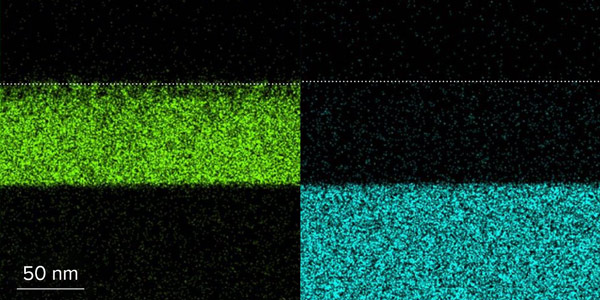Jan. 11, 2024 Research Highlight Physics / Astronomy
A stepping stone to study superconductivity
A thin film reveals the origins of a pre-superconducting phase, which could help research into room-temperature superconductors

Figure 1: A transmission electron micrograph of the material on its substrate. It shows the distribution of iron atoms in the iron selenide thin film (left) and lanthanum atoms in the substrate (right). © Phys. Rev. B
RIKEN physicists have found an ideal platform for exploring the behavior of electrons in a material as it approaches superconductivity1. This could help to develop new superconductors that operate at more convenient temperatures than existing ones.
Superconductors carry electrical current without any resistance, and are used in powerful electromagnets and magnetic sensors, for example. But superconductivity generally only occurs at low temperatures, so researchers are seeking high-temperature superconductors that could open up a much wider range of applications. The ultimate goal is to find materials that superconduct at room temperature.
Superconductivity in so-called conventional superconductors occurs when electrons pair up. This pairing prevents the electrons from scattering as they flow through a material.
Some materials, when they approach this superconducting state, enter a ‘nematic phase’ in which electrons align into stripes. “Nematicity is considered to be closely related to superconductivity,” explains Yuya Kubota of the RIKEN SPring-8 Center. “However, the precise connection between nematicity and superconductivity isn’t fully understood.”
To explore this relationship, Kubota and his colleagues turned to a material called iron selenide, which superconducts only at the very low temperature of –265 degrees Celsius—just 8 degrees above absolute zero. But superconductivity at higher temperatures can be achieved by applying pressure or by tweaking the material’s chemical make-up, potentially pointing the way to more general strategies for creating high-temperature superconductors.
Iron selenide enters its nematic phase at about –183 degrees Celsius. In this phase, the arrangement of atoms in the material’s crystal lattice changes and certain electrons can adopt different energy states. Researchers have long debated the relative importance of these structural and electronic factors for driving nematicity.
Kubota’s team has now come up with an answer. They studied an ultrathin film of iron selenide on a base of lanthanum aluminate, which suppressed the structural change during the transition to the nematic phase.
The researchers spotted all the electronic hallmarks of a transition to the nematic phase, even though the lattice structure remained the same. This suggests that the nematic phase originates only from changes in the energy states of certain electrons.
The researchers anticipate that their thin-film material will allow them to explore the behavior of electrons in the nematic phase, without the complicating factor of any accompanying structural alterations. “This could help us to achieve a deeper understanding of the relationship between nematicity and superconductivity, and the mechanism of superconductivity,” Kubota says. “And this, in turn, could accelerate research toward room-temperature superconductors.”
Related contents
- Stripes within crystals hint at behavior of electrons in quantum systems
- Electrons in iron-based superconductors can pair up in two different ways
- Mind the gap!
Rate this article
Reference
- 1. Kubota, Y., Nabeshima, F., Nakayama, K., Ohsumi, H., Tanaka, Y., Tamasaku, K., Suzuki, T., Okazaki, K., Sato, T., Maeda, A. et al. Pure nematic state in the iron-based superconductor FeSe. Physical Review B 108, L100501 (2023). doi: 10.1103/PhysRevB.108.L100501
